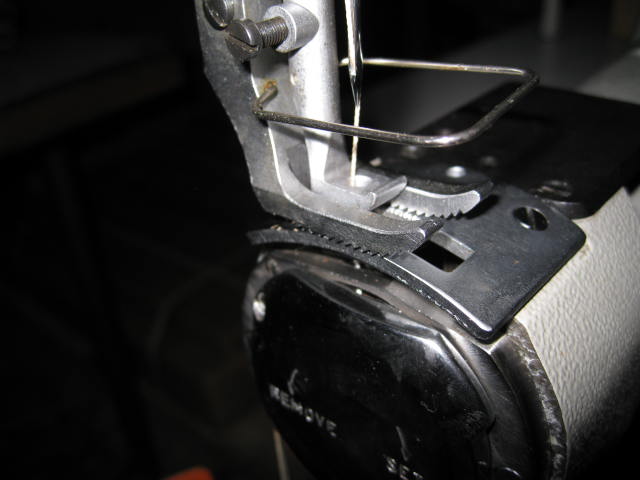
Sooner or later one will have to get a sewing machine. Reasons are just as many as reasons against it and for hand-stitching. Just picture yourself making a western saddle by hand only. Of course you wouldn’t just make the saddle, you’d make a new bridle and reins, a breast collar and a flank cinch and maybe saddlebags even.
All of this would have to be stitched. While it takes about 3 hours to properly stitch a headstall (depending on your style of headstall) – let’s just say we’re not making a cheap one – and it might take even longer to sew your breast collar and the flank cinch, you are spending a whole day of stitching for just the accessory tack. The saddlebags might take you a day and the saddle itself 2 or 3 days if not more. Besides building the saddle, which just takes time, you added about a week’s work to the cost of the saddle. Yes, it’s all handmade and you can be proud of it. On the other hand, if sewn with the machine you’d be finished in half a day with the same quality result or better, depending on your sewing skills.
You probably get where this is leading to…
There are a few serious sewing machines out there and all have their reason and use. Sometimes it feels like you are touching on a religious topic if discussing this.
The following is about the 441. I’m not giving it any brand name as they come in any color and shades of the rainbow. Commonly this machine is referred to as the Juki 441. Juki did start it, but by what I heard, even they are running the clones now.
- Cobra 4
- Brunetti
- Sieck
- Cowboy 4500
- Hightex
- Typical
- Foxsew
- Keestar
- Taking
- Sewpro
This short list is just to name a few of the various names this machine goes by. Basically this is all the same machine. Pretty much all the sellers tell you that there’s is special and put down what others offer. First off, I don’t like that. Does it really matter if one buys a Big Mac at this or the other McDonald’s? Buy definition they should all be the same. And this is true for the head of this machine as well. The difference comes with the details.
If I’m buying an expensive piece of equipment, which this machine is, I don’t want to be left alone after buying it. Therefore local buying is great, but don’t forget the price and follow-up service. In my case I found a seller about 2 1/2 hours away. That ain’t to bad and if I need repair, they will just give me a loaner of the same model at not extra charge. They will even come and pick it up. Now that’s service. Of course this is something one has to look into before closing the deal. You wouldn’t believe what I came across. One guy said he was in business for over 30 years selling industrial sewing machines worldwide and he offered the 441 for sale, but as soon as we were talking on the phone he tried to convince me of his clone of the Adler 205-370, which was 500 EUR more than the 441. It would be more versatile and have better presser feet etc. He didn’t even know about the various presser feet and stitching plates for the 441. At least that’s what he said. Being a salesman he almost convinced me with various samples and that all German saddlers would use a 205-370. Even if that would be true, which it isn’t as there are many out there still using a Pfaff over the Adler, it lead to me to not trust the person.
One guy said that he modified a servomotor to slow down the speed to 1 stitch in 3 seconds. Great if your reaction time is that of a train. If I’d be wanting to sew that slow, in which I can’t see any benefit, I’d be stitching by hand. No point to spend 3,000 EUR. However, a fellow leather worker has pointed out that there are times one wants to have such slow stitching ability. Okay, I’ll wait and see if this will justify 500 EUR on top of all the other clones out there.
Back to the machine. The machine pictured here is the standard setup. At least standard for Germany. Standard is whatever the seller makes his standard. The machine itself comes from China. Even the one that is “made” in Japan, actually come from the same place in China as pretty much all the others. As far as I was able to find out, there are only three manufacturers and the rest are just the sellers or brands. The only thing that’s really different between these machines are the names and colors.
Parts and everything else is interchangeable. That’s really good to know cause you will have to do some shopping around if you want to save some money on parts. There’s a price difference of up to 100%.
Other than the Adler 205-370 the 441 has various presser feet and stitching plates for various tasks. The aftermarket offers some parts for the Adler, but they aren’t nearly as varied as the ones for the 441. This machine is a multi-talent. Some sellers adjust their models so one is able to stitch a whole inch (2.54 cm) or even 1 1/8 inch (2.8 cm). This isn’t a different model at all. It’s just an adjustment. Every 441 can be adjusted to stitch that thick material. The only question is: Do you really need it?






